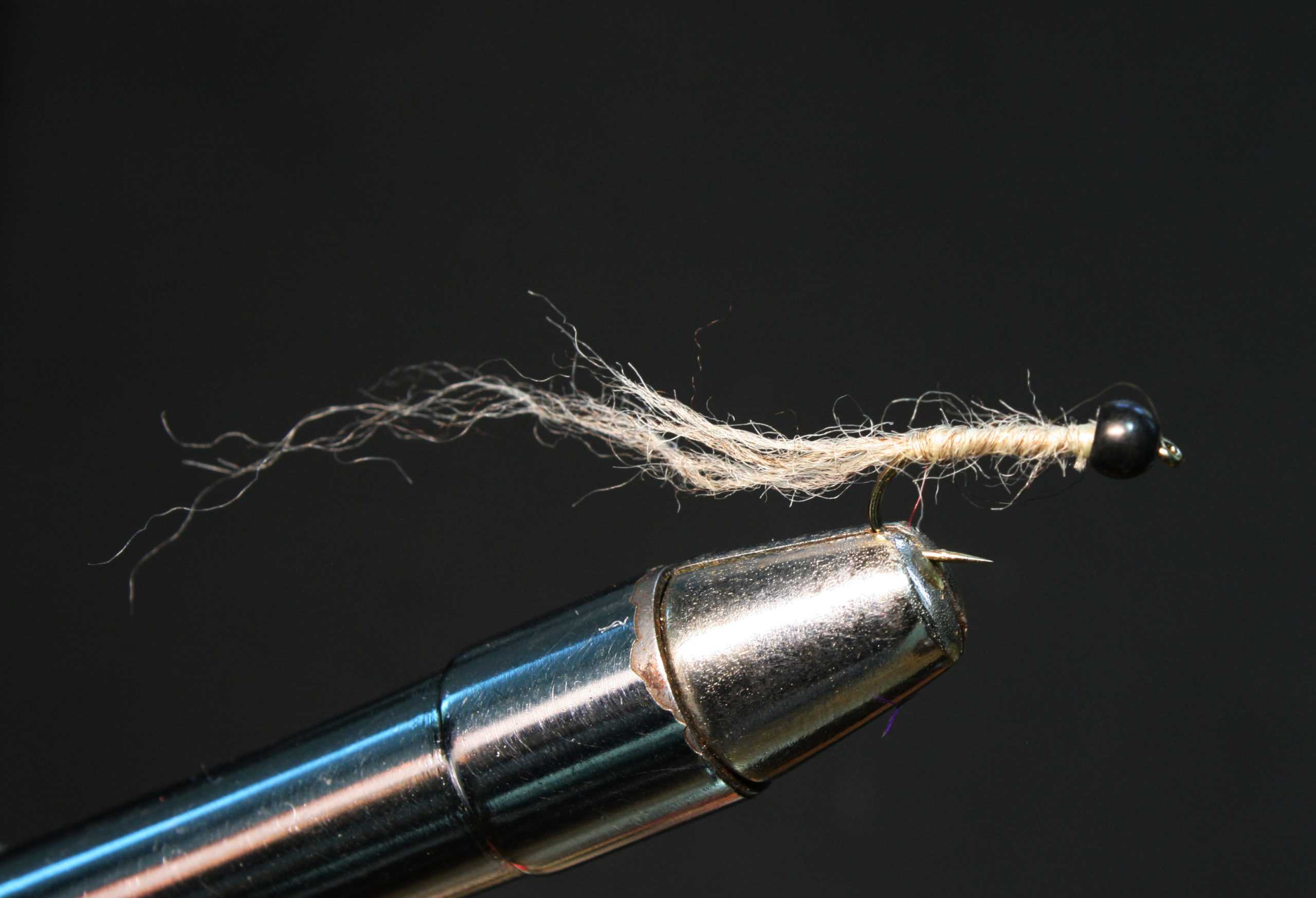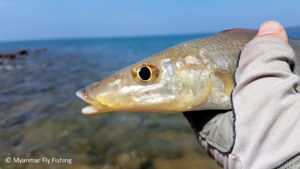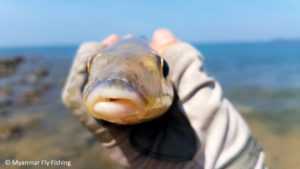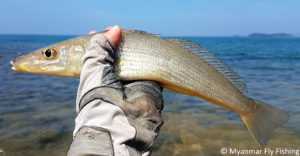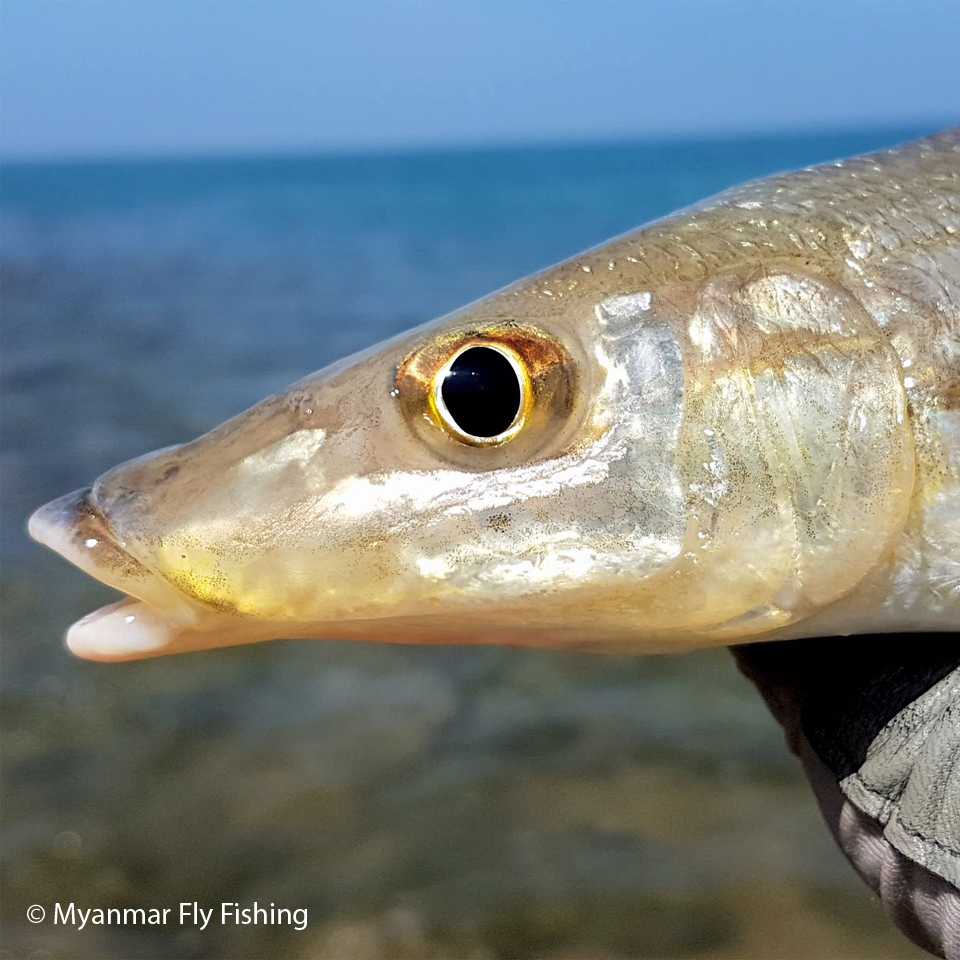
Family: Sillaginidae
Order: Perciformes
Myanmar Name(s): Nga-pa-lwae, Nga-pa-lway, Nga-palwe
Occurrence: Native
Description (Source: Wikipedia)
The northern whiting's similarity to all other species in the genus Sillago has led to many less abundant species being confused with it. The species is known to grow to a maximum size of 31 cm, however reports dating back to 1850 in Bengal suggest the species attains 3 feet (91 cm), which would make it the largest species of sillaginid. These reports were never etched into the literature on the species, possibly because of presumed confusion with the similar but unrelated and larger milkfish and bonefish that inhabit the area. The species has a slightly compressed, elongate body tapering toward the terminal mouth. The dorsal fin is in two parts, the first made of feeble spines and the second of soft rays headed by a single feeble spine, while the ventral profile is straight.
The fin anatomy is highly useful for identification purposes, with the species having 11 spines in the first dorsal fin, with one spine and 20 to 23 soft rays on the second dorsal fin. The anal fin has two spines with 21 to 23 soft rays posterior to the spines. Lateral line scales and cheek scales are also distinctive, with northern whiting possessing 66 to 72 lateral line scales and cheek scales positioned in 3–4 rows, all of which are ctenoid. The amount of vertebrae are also diagnostic, having 34 in total. The swim bladder is the most accurate diagnostic feature, having two posterior extensions and two anterior extensions. The two anterior extensions extend forward and diverge to end on each side of the basioccipital above the auditory capsule. Two lateral extensions also commence anteriorly, each of them sending a blind tubule anterolaterally and then extending along the abdominal wall. The lateral extensions are normally convoluted and have blind tubules arising along their length. The two posterior tapering extensions project into the caudal region, with one usually longer than the other.
The colour of the body is variable, often being light tan, silvery yellow-brown, sandy brown, or honey coloured. The underside of the fish is usually paler, being brown to white in colour. A silver midlateral, longitudinal stripe is normally present. The dorsal fins are dusky on each end, with or without rows of dark brown spots on the second dorsal fin membranes. The caudal fin is dusky terminally, and there is no dark blotch at the base of the pectoral fin as in other sillaginids. All other fins are hyaline, but the anal fin occasionally has a whitish margin.
Biology / Diet / Behavior (Source: Wikipedia)
The northern whiting is the most geographically widespread of the Sillaginidae, but is still confined to the Indian and Western Pacific Oceans. Its easternmost range is from South Africa north along the west coast of Africa and into the Red sea and Persian Gulf. It is common along the Indian and Asian coast, extending to Taiwan and has been recorded in Japan, however these likely are confused with S. japonica. It is common throughout the Indonesian Archipelago, the Philippines and extends as far south as northern Australia. The species has been declared an invasive species to the eastern Mediterranean, passing through the Suez Canal from the Red Sea since 1977 as part of the Lessepsian migration, becoming widespread.
The northern whiting is primarily an inshore species, rarely seen in depth of more than 20 m. It commonly inhabits both high energy beaches and sandbars as well as more protected bays along mangrove creeks and tidal flats. The species commonly enters estuaries, and has even been recorded in freshwater, despite the fact it has no anatomical adaptations to cope with this change. The northern whiting does not migrate or move offshore at various times of the year like some co-occurring sillaginids.
Like most members of the family, S. sihama can bury itself in the sand when danger approaches and commonly avoids seine-nets by employing this behaviour, giving them the common name 'sandborer' in some countries.
The principal items of diet are polychaete worms, small prawns and copepods, with other Crustacea including Decopoda, Ocypoda, shrimps, and amphipods also taken. Small fish are often taken and filamentous algae is consumed. Australian specimens frequently contain polychaete worms and small Crustacea. The species often has a similar, but slightly different diet compared to other coexisting sillaginids and other fishes, with few cases of wide dietary overlap recorded. The juveniles and adults also show disparity in their diets, with juveniles taking zooplankton such as copepods, while adults take larger crustaceans and polychaetes.
Spawning occurs year round, but a peak of spawning activity occurs once during the year at variable times over the species range. Peak of spawning in Thailand is August and November.


